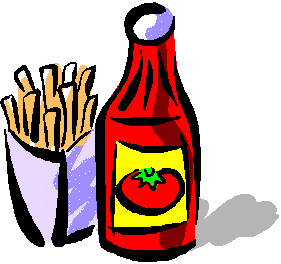Class Ketchup
Social Studies Lesson Plan
Students will be involved in making homemade ketchup. They will compare theirs to store-bought brands and learn some general ketchup facts.

ingredients for ketchup recipe, a portable stove, large saucepan, strainer, several bowls, measuring cups and spoons, a container for finished ketchup, a large reproduction of the ketchup recipe; here are some ketchup facts
- Ask your kids the following questions and keep a tally for the responses.
- Do you like ketchup?
- Do you have ketchup at home?
- What brand is at your house?
- Have students brainstorm a list of things that they think ketchup is made of. Write these on board or overhead.
- Split class into groups. Give each group a different kind of ketchup. Have them look at the ingredients. Cross out those ingredients on the class' list that are not found on any of the bottles, and add those to the list that the class didn't think of.
- Tell students that they will be making their own ketchup from scratch. Present the included recipe and discuss with class.
- Now you are ready to make the ketchup. You really have to decide the best way to organize this part of the lesson for your particular situation. However, dividing them into groups will give them more hands-on experience than will making the recipe as a whole class. You may want to have parents come in to help out. They can actually be in charge of a cooking center. They can call the class by groups to each prepare their own batch of ketchup. The group can help do the initial cooking of tomatoes by taking turns at the stove. The simmering part is what will take a long time. If you have access to several stoves you can just let them cook in the class, with students periodically checking on it. If not, you may want to see if parents can take a batch home to simmer it and bring it back in the morning. You will have to decide what works best for you.
- Mini-Theme Idea: An idea you may want to consider is making the whole day ketchup related. You can have different centers all day dealing with ketchup/tomatoes. Here are some ideas:
- Math: Measurement, average number of seeds in tomatoes, ketchup statistics (some included in this fact sheet) , surveys from taste tests
- Science: bottling plant, how tomatoes grow, the tomato plant, can ketchup spoil?, scientific observations of tomato
- Social Studies: history of ketchup, use of tomatoes around the world, what countries are tomatoes native to?
- Language Arts: books on tomatoes, ketchup, and large ketchup companies, words within ketchup, advertise your own original ketchup product
- Art: design your own ketchup bottle/logo, still life of tomatoes or ketchup bottle, place in a background
- After the ketchup has been made, have students taste their groups' ketchup. They should name it. Place all of the class ketchups as well as some store bought ones out on a table, and have students do a taste test.
- Tally results for the test and make a simple graph as a class. Discuss the results. Discuss how large ketchup companies don't make ketchup by hand, but have huge plants where machines do most of the work.
Share some ketchup trivia with you class . Compare this trivia with some of the students' responses in the beginning of the lesson (i.e. do they like ketchup?, what brand do they use?). Have students reflect in writing about their experience making ketchup. Does it change their "feelings" about the condiment? Would they use ketchup if they had to make it from scratch each time? Were they familiar with some of ketchup's ingredients before the lesson?
Were your kids able to reasonably name things that might be in ketchup? Were they involved throughout the lesson? What parts did they seem to like/dislike the most? Were they willing to participate in the taste test? Do their reflections show what they gained from this experience?


